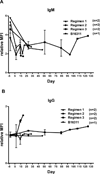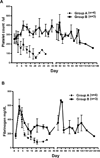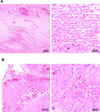Pig-to-baboon heterotopic heart transplantation--exploratory preliminary experience with pigs transgenic for human thrombomodulin and comparison of three costimulation blockade-based regimens
- PMID: 25847282
- PMCID: PMC4464944
- DOI: 10.1111/xen.12167
Pig-to-baboon heterotopic heart transplantation--exploratory preliminary experience with pigs transgenic for human thrombomodulin and comparison of three costimulation blockade-based regimens
Abstract
Background: Three costimulation blockade-based regimens have been explored after transplantation of hearts from pigs of varying genetic backgrounds to determine whether CTLA4-Ig (abatacept) or anti-CD40mAb+CTLA4-Ig (belatacept) can successfully replace anti-CD154mAb.
Methods: All pigs were on an α1,3-galactosyltransferase gene-knockout/CD46 transgenic (GTKO.CD46) background. Hearts transplanted into Group A baboons (n=4) expressed additional CD55, and those into Group B (n=3) expressed human thrombomodulin (TBM). Immunosuppression included anti-thymocyte globulin with anti-CD154mAb (Regimen 1: n=2) or abatacept (Regimen 2: n=2) or anti-CD40mAb+belatacept (Regimen 3: n=2). Regimens 1 and 2 included induction anti-CD20mAb and continuous heparin. One further baboon in Group B (B16311) received a modified Regimen 1. Baboons were followed by clinical/laboratory monitoring of immune/coagulation parameters. At biopsy, graft failure, or euthanasia, the graft was examined by microscopy.
Results: Group A baboons survived 15 to 33 days, whereas Group B survived 52, 99, and 130 days, respectively. Thrombocytopenia and reduction in fibrinogen occurred within 21 days in Group A, suggesting thrombotic microangiopathy (TM), confirmed by histopathology. In Group B, with follow-up for >4 m, areas of myofiber degeneration and scarring were seen in two hearts at necropsy. A T-cell response was documented only in baboons receiving Regimen 2.
Conclusions: The combination of anti-CD40mAb+belatacept proved effective in preventing a T-cell response. The expression of TBM prevented thrombocytopenia and may possibly delay the development of TM and/or consumptive coagulopathy.
Keywords: baboon; complement-regulatory proteins; costimulation blockade; heart; pig; thrombomodulin; thrombotic microangiopathy; xenotransplantation; α1,3-galactosyltransferase gene-knockout.
© 2015 John Wiley & Sons A/S. Published by John Wiley & Sons Ltd.
Conflict of interest statement
Carol Phelps and David Ayares are employees of Revivicor, Inc. Keith Reimann is an employee of Mass Biologics. No other author has a conflict of interest.
Figures





References
-
- Kuwaki K, Tseng YL, Dor FJ, et al. Heart transplantation in baboons using alpha1,3-galactosyltransferase gene-knockout pigs as donors: initial experience. Nat Med. 2005;11:29–31. - PubMed
-
- Tseng YL, Kuwaki K, Dor FJ, et al. alpha1,3-Galactosyltransferase gene-knockout pig heart transplantation in baboons with survival approaching 6 months. Transplantation. 2005;80:1493–1500. - PubMed
Publication types
MeSH terms
Substances
Grants and funding
LinkOut - more resources
Full Text Sources
Other Literature Sources
Medical
Miscellaneous

